

STREET VERISMO
by Robert Sievert


see larger-size view.
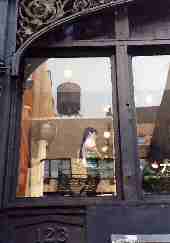
David Silberstein: Girl in 123

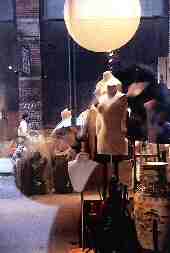
David Silberstein: Manniquins in Shop

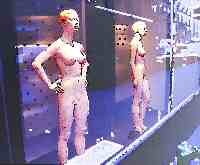
David Silberstein: Two Manniquins Sans Red


Here is the spectacle of lives lived in the open for all to see, oblivious of all around them and focused on their small worlds. There is a whole genre of street art now emerging as artists are back to trying to find that elusive "truth" in seeing life on the streets: an attempt to get that feel of life from some documented street scene. It has long be held in ART that the truth of it all (verismo) lay somewhere out there on the streets.
Two recent shows of artists who deal with New York street life share values but differ in their approaches to the subject matter. Both David Silberstein and Myron Heise are artists who have deeply delved into life on the streets and while very far apart in finished image, their accomplishments are both closely linked with their devotion to the intimacy and revelation on city streets.
On view at Magnetic Image are the digitally enhanced photographs of David Silberstein. Here is a collection of pictures looking into windows and doors on streets you are sure you have been down.
Silberstein is the crafty voyeur afoot with his camera, ready to catch that moment that shows us the absolute vulnerability of life on the streets. His pictures are a glimpse into interior space, a man is caught looking intently at half nude mannequins, unforgiven..he is alone with private thoughts inspired by two scantily dressed mannequins in a store window. We sense his deeply private state. Caught in libidinous fantasy, the subject of this photograph is not seen for his character but rather his complicity in a very private moment.
This photographer roams the streets looking for this kind of private image..his pictures are layered images, digitally enhanced to bring a them within a color range that manages to contain a feeling of emotional resonance: a woman with a cigarette becomes an image of ruinous self indulgence; mannequins in a window epitomize vulgarity; and diners seen through restaurant windows are undisturbed by the camera’s scrutiny.
The work clearly capitalizes on the double entrendre of mannequins as stand-ins for dreams and fantasy, as Silberstein photographs them in factory windows, or half undressed in store windows, as well as a few that have landed in the land of the tenderloin, sporting push-up bras, and hot pants.
Silberstein also strikes a wonderful balance: of timeless architectural detail such as the molding on a window framing an unexplained scene. He also uses the overlapping planes of the windows and street to excellent effect.. There is something going on with the overlapping planes. The constant interplay of reality and reflection keeps the viewers on their toes.
Limited to a few basic themes, Silberstein;s work develops an intensity that can only be seen as the sum of experience.

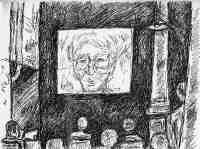
Myron Heise: The Face on the Screen
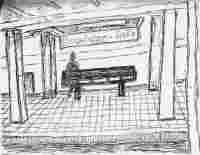
Myron Heise: Broadway-Lafayette
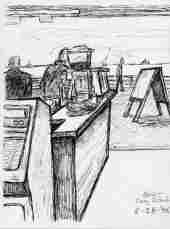
Myron Heise: Coney Island
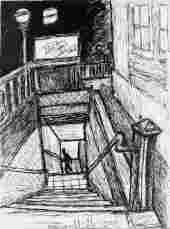
Myron Heise: Man on the Subway Stairs
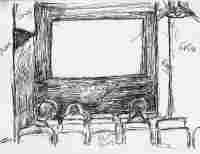
Myron Heise: People in Movie Theater
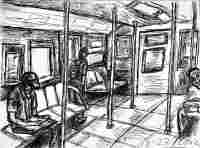
Myron Heise: Subway Trip
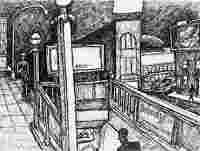
Myron Heise: Two Men at the Subway Station
Most effective are his pen and ink drawings. They certainly capture the feeling of special time and place as he is clearly out there on the street using his pen and paints to record that which he encounters. Perhaps this is the most engaging aspect of his work, a verismo of images, that places the viewer in some late night corner of lower Manhattan or some lovely park.
In a recent conversation, Heise listed some of his favorite painting and drawing sites: Movie theaters (he loves that big white screen onto which to put images). He also mentioned drawing in a subway at night, mostly at the Bowery and Delancey stop, Coney Island with its exciting Boardwalk, as well as Forsythe Park, that sliver of Green in East Chinatown below First Avenue.
Nowhere is Heise's interest in the streets more apparent than at Macelleria, a charming Continental restaurant at 48 Ganesvoort Street, where an extremely well focused show, organized by John Silver, offers paintings of the Meat Packing District. As a matter of fact in a recent conversation Heise spoke of a group of artists he meets and paints with on Sunday mornings in this West Village neighborhood . At Macelleria the paintings line the wall and are beautifully lit. I was especially taken with the paintings of Patricia Melvin. Her skies have a depth and joy. A smaller painting of Melvin's was jewel-like. Also notable were the paintings of Ronald DeNota, which seemed to possess an inspired inner light.
Heise's contribution to this show are several views of the Meat Packing district at off times. No crowds, vans or racks of meat to be seen. His semi-deserted streets are lonely but enlivened by a sense that anything might happen at any moment.
In previous years Myron Heise has painted New York City at night. His vision incorporated those things that seemed at the time quintessential "city": newsstands, subway platforms, and the flashy night life along the Tenderloin. Who at the time would think that some day these things would only be "sweet memory". Giuliani's tenure as mayor wiped out most of the world Heise portrayed, and now his images seem to document a world that once was. Even his subway scenes are placed in retrospect by the new "artier" stations with art and installations he readily admits to .
Also to be noted are the paintings of Alan Streets that sit in a window of a fur salon on the corner of Seventh Ave and 29th Street. These paintings are twisted and warped views of familiar New York City icons piled and squeezed into a rather intense picture space. His buildings and forms have a twist to them. These paintings may not be exactly “truthful” in nature but they do touch on a certain nerve.
Uptown and downtown "Street Verismo" is becoming more a part of the Art Scene, and why not? It's collectable and accessible.

Copyright © 2003 Robert Sievert
 back to Contents page
back to Contents page